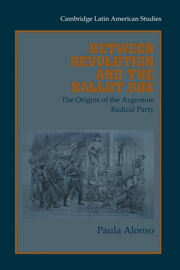Book contents
- Frontmatter
- Contents
- Acknowledgments
- List of Abbreviations
- List of Tables and Figures
- Introduction
- 1 The Political Arena
- 2 Mounting an Opposition
- 3 The Short-Lived Unión Cívica
- 4 The Radicals in Action: Part I
- 5 The Radicals in Action: Part II
- 6 The Decline of the Radical Party
- Conclusion
- Appendix 1 A Chronology of Political Parties and Factions, 1862–1910
- Appendix 2 Details of the Members of the National Committee of the UCR in 1892
- Appendix 3 Property Values in Buenos Aires, 1890–1898
- Bibliography
- Index
1 - The Political Arena
Published online by Cambridge University Press: 05 August 2011
- Frontmatter
- Contents
- Acknowledgments
- List of Abbreviations
- List of Tables and Figures
- Introduction
- 1 The Political Arena
- 2 Mounting an Opposition
- 3 The Short-Lived Unión Cívica
- 4 The Radicals in Action: Part I
- 5 The Radicals in Action: Part II
- 6 The Decline of the Radical Party
- Conclusion
- Appendix 1 A Chronology of Political Parties and Factions, 1862–1910
- Appendix 2 Details of the Members of the National Committee of the UCR in 1892
- Appendix 3 Property Values in Buenos Aires, 1890–1898
- Bibliography
- Index
Summary
Thomas Turner, the River Plate correspondent of The Times in the 1880s, suggested in his memoirs:
There are many otherwise well-informed persons, we believe, who still entertain the antiquated notion that the Argentine Republic is a wild and lawless region, of vast territorial extent, sparsely populated, and mainly the resort of desperate characters, ready at any moment to break out into political revolt; where murder is rife, and life and property illprotected.
By the late 1880s, the notion of Argentina as a wild region inhabited by brutal natives was indeed out of date. The country had recently and rapidly transformed. Certain institutional, economic, and social changes in fact predated the 1880s. By then, the new National Constitution had been in force for two decades and three presidents had been elected under its terms: Bartolomé Mitre (1862–1868), Domingo F. Sarmiento (1868–1874), and Nicolás Avellaneda (1874–1880). Argentina had, since the 1860s, expanded its cereal and beef production and accommodated increasing numbers of European immigrants. However, in the light of later developments, the pre-1880 socio-economic growth can be seen as the harbinger of the overwhelming changes that Argentina experienced during the 1880s. These were crucial years in Argentine history: They witnessed the consolidation of Argentine institutions, the definition of the political system that was to dominate the country for the next thirty-six years, and the establishment of the conditions that fostered Argentina's rapid socioeconomic transformation.
- Type
- Chapter
- Information
- Between Revolution and the Ballot BoxThe Origins of the Argentine Radical Party in the 1890s, pp. 14 - 46Publisher: Cambridge University PressPrint publication year: 2000

